25592997 Dropped Call Hotspot Clustering

The initiative known as “25592997 Dropped Call Hotspot Clustering” aims to systematically identify areas within cellular networks prone to dropped calls. By employing data analytics and machine learning, it reveals significant geographic patterns linked to service interruptions. This understanding can inform network improvements. However, the implications of these findings extend beyond mere technical adjustments. They raise critical questions about user experience and competitive strategies in the telecommunications sector. What transformations might emerge from this analysis?
Understanding Dropped Call Hotspots
Dropped call hotspots represent critical areas within cellular networks where users frequently experience interrupted service.
These locations can significantly degrade user experience, leading to frustrations and dissatisfaction.
Factors contributing to dropped calls include network congestion, insufficient infrastructure, and geographical obstacles.
Understanding these hotspots is essential for network providers aiming to enhance service reliability and ensure users maintain their communication freedom without disruptions.
Analyzing Geographic Patterns
Geographic patterns play a pivotal role in identifying and understanding dropped call hotspots within cellular networks.
By analyzing the geographic distribution of these incidents, researchers can employ pattern recognition techniques to reveal underlying issues. This analytical approach facilitates the optimization of network resources, ultimately enhancing user experience and connectivity.
Understanding these patterns empowers stakeholders to address problem areas, ensuring a more reliable cellular infrastructure.
Technologies for Identifying Clusters
Cluster identification in the context of dropped call hotspots relies on advanced technologies that leverage data analytics and machine learning algorithms.
By employing machine learning techniques, analysts can uncover patterns within vast datasets, while data visualization tools enhance comprehension of these clusters.
This synergy facilitates effective identification of problem areas, ultimately leading to improved network performance and user experience through informed decision-making.
Implications for Users and Service Providers
While the identification of dropped call hotspots presents significant challenges, it simultaneously offers critical implications for both users and service providers.
Enhanced understanding of these clusters allows service providers to improve network infrastructure, thereby bolstering service reliability.
For users, this translates to a more seamless user experience, ultimately fostering user satisfaction and loyalty in a competitive telecommunications landscape.
Conclusion
In conclusion, the “25592997 Dropped Call Hotspot Clustering” initiative serves as a beacon, illuminating the shadowy corners of cellular networks fraught with service interruptions. By identifying these geographic clusters, the initiative not only unveils the underlying patterns of user dissatisfaction but also empowers service providers to fortify their infrastructure. This proactive approach symbolizes a bridge, connecting technological advancement with enhanced user experience, ultimately transforming fleeting connections into a robust tapestry of reliable communication.




